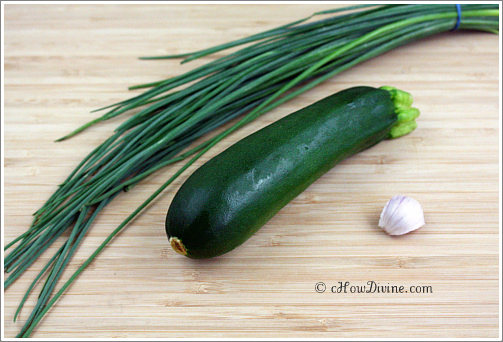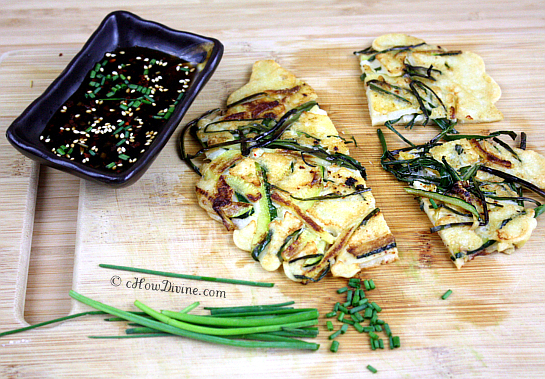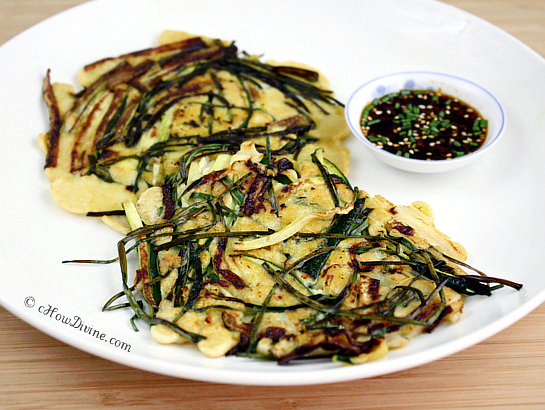Pajeon (Korean Scallion Pancakes) is probably one of the most popular appetizers in Korean cuisine. Whenever we go to a Korean restaurant, we don’t have to look far to spot a Pajeon atop someone’s table.
There is a good reason for this. Obviously, Pajeon is delicious. But it’s also a “safe” dish for those who are not familiar with Korean cuisine. As much as I LOVE Korean food, I must admit some dishes are an acquired taste. (Once acquired though, they are addictive!) But the scallion pancakes are comforting and familiar regardless of your origin or taste. They are savory and crispy when eaten right out of the skillet and piping hot. And they are savory and chewy when eaten at room temperature. The choice is yours. Ooh~ And don’t get me started on the salty, tangy dipping sauce.
I made gluten-free pajeon using brown rice flour and sweet/glutinous rice flour. But if you don’t have any dietary restrictions, go ahead and use all-purpose flour. That’s what I grew up on. And I used buchu (Korean chives) for this recipe instead of scallions, because scallions tend to be thicker and tougher in the summer time. But you can still used scallions. Just split the scallion greens in half – length-wise – to make them more manageable. Additionally, I made the dipping sauce lighter, without any oil, because of this oppressive heat we are experiencing this year. But if you want the more traditional dipping sauce, here it is.
It’s one of those dishes that are very easy to make in a short amount of time. So impress your family and friends at your next gathering with this tasty and eye-pleasing appetizer/side dish.
Pajeon (Korean Zucchini Scallion Pancakes) Recipe
Makes 4, 5-6 inch pancakes
Ingredients
Pancakes
1 cup gluten-free (rice) flour* or all-purpose flour
1 bunch spring onions, green parts only or buchu (Korean chives)
1 small zucchini, cut into matchsticks
1/2 tsp sea salt + 4 small pinches
3/4 cup ice-cold water + more as needed
1 egg, beaten
canola oil
Dipping Sauce
1 TB rice vinegar
2 TB tamari
1 small garlic, minced
toasted sesame seeds
gochugaru (Korean chili pepper flakes) or
2 or 3 pickled jalapeño, cut into rings
1/2 tsp agave nectar or honey: optional
*Note: I used my own gluten-free mix (3/4 cup brown rice flour + 1/4 cup sweet or glutinous rice flour). You can experiment with your own blend. Brown rice flour and tapioca flour also work well together. If you are using all-purpose flour, replacing 1/4 of the all-purpose flour with glutinous rice flour will improve the texture. For vegan pancakes, skip the egg and increase the amount of water to 1 cup instead of 3/4 cup.
- Make the base of the dipping sauce by stirring together vinegar, tamari, minced garlic, and agave (if using). Sprinkle a pinch or two of crushed toasted sesame seeds and gochugaru. You can add pickled jalapeño rings, instead of the sesame seeds and gochugaru, for the spicy zing. Set aside.
- Wash and dry the scallions/chives and zucchini. Cut the scallions/chives into 3-4 inch pieces. If you are using scallions, use the green parts only. Cut the zucchini into matchstick-sized pieces.
- Whisk together the flour and salt. If you are using all-purpose flour, don’t over-mix; you will end up with dense and tough pancakes. Combine the dry ingredients with egg and water. Stir to achieve a batter that is slightly runnier than your regular breakfast pancake batter.
- Heat a non-stick pan. Add 1 TB of canola oil. Once the pan is hot, add 1/4 of the zucchini and sauté for about a minute until it starts to wilt. Add 1/4 of the scallions/chives to the zucchini slices. Add a small pinch of salt. Sauté until slightly brown. Shape or spread out the zucchinis and scallions/chives into a size(5-6″)/shape you want the pancakes.
- Pour about 1/4 of the batter over the vegetables and smooth it out using your ladle in a circular motion. Cook until the bottom is golden brown, about 3 minutes. Flip over using a spatula and cook for another ~ 3 minutes until the other side is golden brown. Repeat with rest of the batter.

Serve the pancakes hot or at room temperature with the dipping sauce from step 1.
**For additional tips, please read my response to Sarah’s comment in the comments section below.
I noticed that many people are using different types of flour and want to know what the consistency of the batter should be. The best way to test it is by combining 1 TB of all-purpose flour with 1 TB of water (with a sprinkle of salt). Make sure you don’t pack the flour and make sure that it is a full tablespoon of water (and no more). Mix gently. It may seem a bit runny to you, but this is the way the consistency of the batter should be. And then, pour the batter onto a hot oiled pan. Cook about 2 minutes on each side until golden brown. Bite into it. It should be slightly chewy and crispy around the edges. This is what the texture should be. So when you use a different type of flour, you know exactly what the consistency of the batter and the texture of the finished product should be.



I have never had this before, but I’m glad I saw this, this looks great! I;m hungry all over again
Thanks for coming by the site! I hope you get a chance to try these. They are really tasty!
These are my favorite Korean pancakes! I’m gonna have to try the rice flour mixture. Excited to try this!
Thanks Nicole! I like them the best with rice flour!
I love pajeon! and so excited to get your gluten free version. must try it this weekend.
Please do! I’m probably going to make some this weekend also!
I just made pajeon using chives & your gluten free mix (rice & glutinous rice combo) for dinner. The chives are from my mama’s garden, she’s very happy to learn a new recipe to cook her chives and she couldn’t get enough of the pajeon! didn’t get to take any photos because we’re all too hungry 😀
My pajeon turn out quite thin, a bit thicker than crepes texture. Maybe because I swirl the batter like I’m making crepes.. 🙂 Should I put the batter like pancake size? or do I put more batter to make a thicker texture? I follow the same amount of batter in your recipe and I got 3 “crepe” size pajeon.. lol
Hey Shannon! Wow! How did you get 3 crepe sized pancakes!!! 🙂 Must have been very thin? 🙂 I get about four, 5-6 inch, pancakes! I usually make my rice flour pancakes smaller because of the lack of gluten and its ability to bind things together. Glutinous rice flour and the egg does it to a certain degree, but not to the extent of gluten in all-purpose flour. I’m impressed that you were able to flip the sucker! You must have mad skills! 🙂
You don’t use “flour” for traditional Korean pancakes. Instead use ground skinned mung bean meal. This can be bought at the oriental grocery store. My first attempt, I used flour– turned out crap. Then I went to the O store and found out from the owners how to make them.
Hey Sarah! As a Korean American, who grew up in a very traditional Korean household, I can assure you that this is an authentic Korean pancake. Contrary to your comment, there are many different types of Korean pancakes.
The most popular and well known types are Pajeon, Nokdu Bindaetteok, and Gamjajeon (to a lesser degree). Pajeon is generally made with flour. Nokdu Bindaetteok is made with mung beans. This is the one that you are referring to, and I happen to have a recipe for that here. And Gamjajeon is made with potatoes. So, to say that there is only one type of traditional pancake would be a disservice (and it would be misinformation) to Korean cuisine. It’s like saying there is only one type of kimchi!
With that said, Pajeon does not use baking soda/powder as a leavening agent, meaning it will not fluff up like a traditional American pancake. So you need to be more mindful of the thickness of the pancakes and the consistency of the batter. If you make the pancakes too thick, it will be too dense and taste like a hunk of flour. Not good. If you don’t add enough water to the batter, it will taste too gritty and again dense. So yes, it will taste “crap”-py in either of the scenarios just mentioned. But these can easily be remedied. Remember that the consistency of the batter should be slightly runnier than the pancakes you are used to. You can just add a TB or 2 of water if it’s not. No big whoop!
If you are using all-purposed flour, it will be beneficial to replace 1/4 cup of the AP flour with glutinous or sweet rice flour. This will go a long way in yielding soft and chewy pancakes. And if you want the sort of grainy texture of mung bean pancakes, you can replace another 1/4 cup of AP flour with cornmeal. And for substantial/heftier pancakes that you can eat as a meal, you can add some oysters or chopped shrimp. The possibilities are endless!
I hope you give these pancakes a try. If you choose not to, here is the recipe for Nokdu Bindaetteok (mung bean pancakes). If you have any questions, don’t hesitate to ask!
I adore pancakes – I have never had Korean pancakes but I must give them a try. Thank you for sharing this recipe!
You’re so welcome! You should really give them a try. They aren’t your typical sweet pancakes, but they are delicious nonetheless!
I love these pancakes and I am going to add them to my Mouth Watering Mondays post this Monday. Come on over to see it at http://www.noshingwiththenolands.com Cheers, Tara
Thanks Tara! I’ll be sure to come by!
I never thought about savory pancakes but they look pretty good
They are one of my favorite appetizers! The dipping sauce really rounds out the dish!
I LOVE pajeon! I can’t wait to make this! Yummy!
Me too. I’ve been making these like crazy lately!
This is an interesting and a new recipe for me to try…By the way, I love your new profile picture.
Myfudo here…Normally we’d never put a shameless plug back to us, but we just launched our new site and we would love for you to be a part of it. I’d love to share our newest launch with you, I hope you don’t mind? Now that we are getting a new look…Myfudo is moving to a new domain http://www.yumgoggle.com This has been a project we have been working on for almost a year now. We just launched our new gallery submission site, and we are just thrilled. We’d be proud to have your work as part of our growing collection to continue to have a larger reach and further inspire all fellow food lovers out there! Please sign up and check us out (it’s free) http://www.yumgoggle.com/gallery
We look forward to seeing your wonderful pictures, as always.
p.s. We are hosting a Kitchen Aid Mixer Giveaway to celebrate our new Yumgoggle site, we hope you’ll participate =)
http://www.yumgoggle.com/japanese-cuisine-japanese-spinach-side-dish-horenso-no-ohitashi-kitchenaid-mixer-giveaway/
Thanks! We are all entitled to a few shameless plugs in our life time. 🙂 I don’t mind at all. I will be sure to check it out! Best of luck!
Hi,
I made these last night. I was very excited to try something new. I used 1/2 all purpose flour and half quinoa flakes. They were definitely a little gummy/chewy. I am not sure if that was because of the quinoa or because they cooked too long. The batter was so thick that it sat on top of the veggies instead of seeping all the way through. I was however able to flip them after letting them cook for a minute. But they tasted good with the sauce. I have never had these anywhere else. I was wondering what is the texture supposed to be like? Are they supposed to be like actual American pancakes- light and fluffy or are they supposed to be more like an omelette?
Hi Brigitte! Thanks for the comment. I’m glad you decided to give these a try. I’m not sure what quinoa flakes are like. But if they are anything like oat flakes or almond flakes, they absorb quite a bit of water. And because of this, I don’t think they are suitable for these pancakes. You need to add more water at the very least to thin out the batter. The batter needs to be slightly runnier than the American pancake batter. You have to remember that these don’t have baking soda or powder to add air to the batter to make them fluffy. So if you make the batter just as thick or thicker, it will just sit there like a hunk of rock. If you look at my images, the pancakes are thinner than your American pancakes. This occurs semi-naturally if your batter is runny enough (not watery tho!) because they will seep into the veggies and spread out. You can use the back of your ladle to aid in the process. And as far as the physical thickness of the pancake, they should definitely be thicker than a crepe but thinner than an American pancake.
The texture of these pancakes are quite different from American pancakes or the omelette. They are slightly chewy, but not as chewy as mochi.
Update: I don’t know why I didn’t think of this before, since this is how I test my batter with different types of flour. You can tell what the consistency of the batter should be by COMBINING 1 TABLESPOON OF ALL-PURPOSE FLOUR WITH 1 TABLESPOON OF WATER (add a sprinkle of salt). It may seem a bit runny to you, but this is how the batter should be. And then, pour the batter onto a hot oiled pan and cook on each side for about 2 minutes each. Bite into it. This is what the texture should be like. If you added salt to this batter, it tastes pretty damn good just the way it is! 🙂
So now if you want to use a different type of flour, you know what the consistency of the batter and the texture of the pancake should be. I hope this helps.
Thank you so much for your reply. My pancakes were definitely not the consistency you refer to. I will try them again. I thought quinoa flakes would be a good substitute since I did not have any other suitable gluten free flour on hand. I’m going to try them again. Thanks for the tips!
You’re welcome! If you don’t have any sensitivities, you can just use all-purpose flour. You can’t really beat the texture and taste of it.
These are truly awesome! I am a huge scallion pancake fan and just love the look of these. I probably would not be able to stop eating them once I started. Thanks so much for sharing this recipe!
Thank you MJ! These are one of my favorite Korean appetizers! I usually end up eating way too much of this and fill up on it before I start on the main meal. 🙂
Finally, I found this recipe. I tried it today but my batter was thin because I put about 1 cup cold water. It taste like a crepe ,Lol. However, me and my mom finished it less than 5 mnt. Next time I will double the recipe so I can it more, haha…
About the mungbean pancake, does the batter need to strain or the sandy texture is what I’m looking for?
Hi Mei! Yes, a cup would have been a little much. 😀 It’s ok tho. I think you need to make it at least once to figure out the right consistency. Just make sure that it’s not too watery; if it’s too watery, the batter will spread out very quickly even on a hot pan to a size of a crepe! Haha,it happens to the best of us. After making it a few times, you won’t even have to measure it. You’ll know it by eying the consistency.
With mung bean pancakes, you want a slightly heartier consistency. It won’t be chewy like the scallion pancakes. If you blend the beans in a powerful blender, it will be pretty smooth. It still won’t be flour-like smooth. DON’T strain it. You want that heartier texture. Let me know if you have any other questions.
I’ve tried several variations of AP flour or combo of AP flour with rice flour or glutinous flour and I have to say that your recipe using entirely rice flour comes out the best and produces the most crispy pajeon. Thank you.
Glad to hear. Thanks for visiting our site!